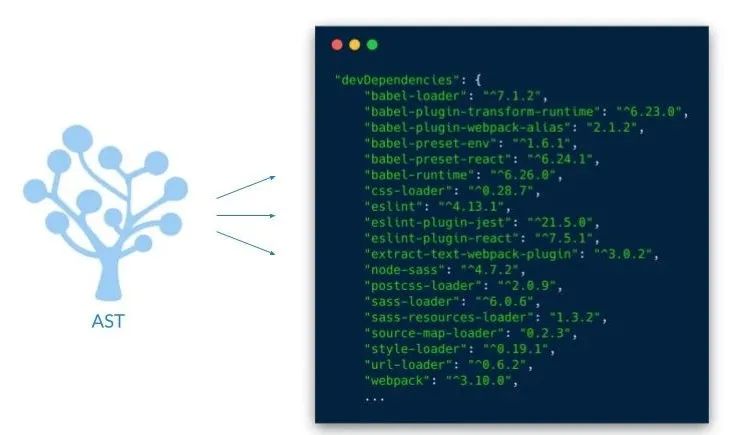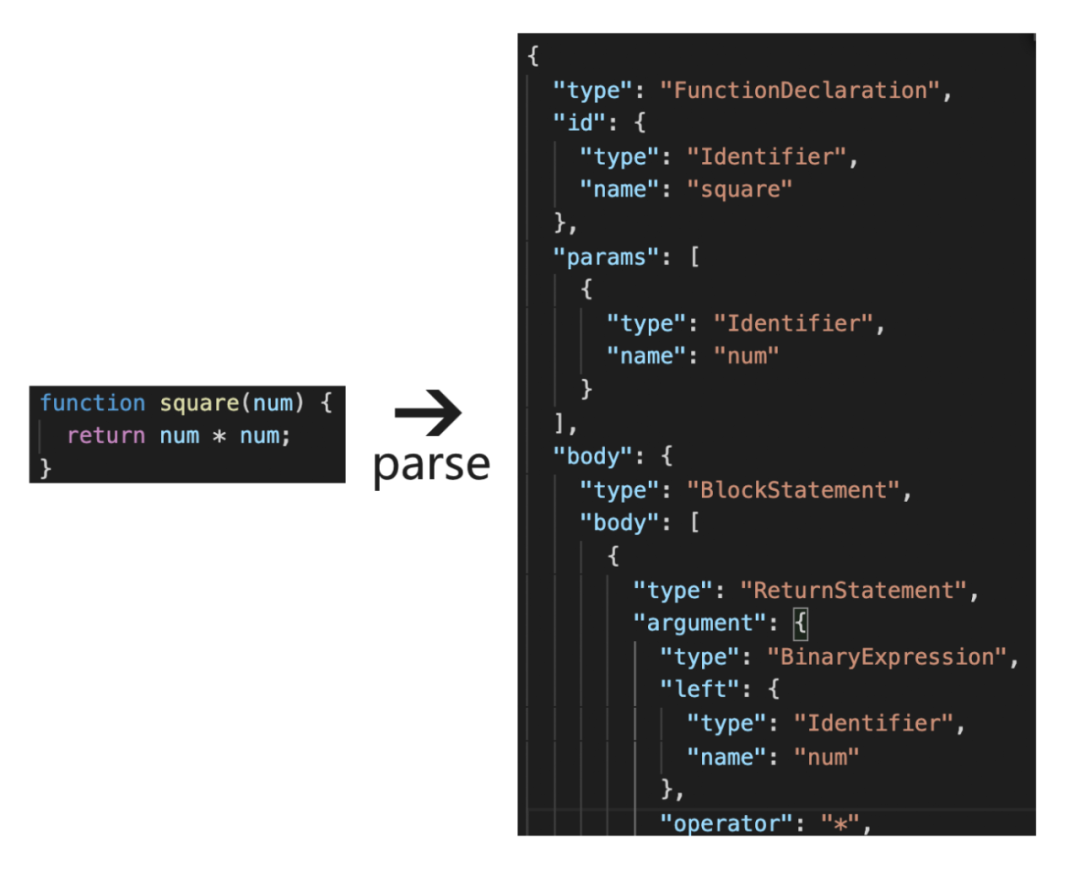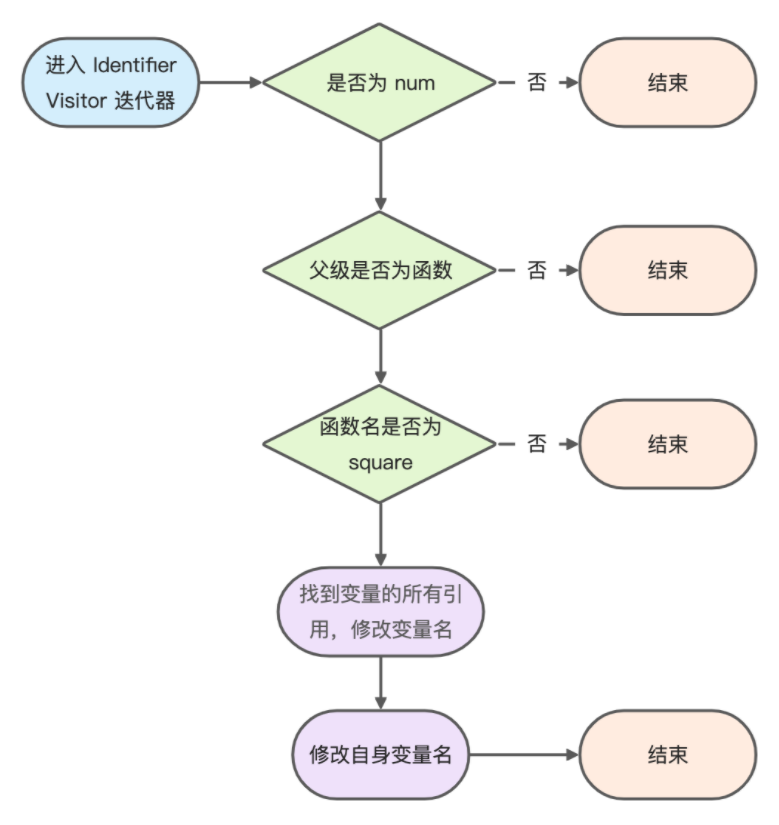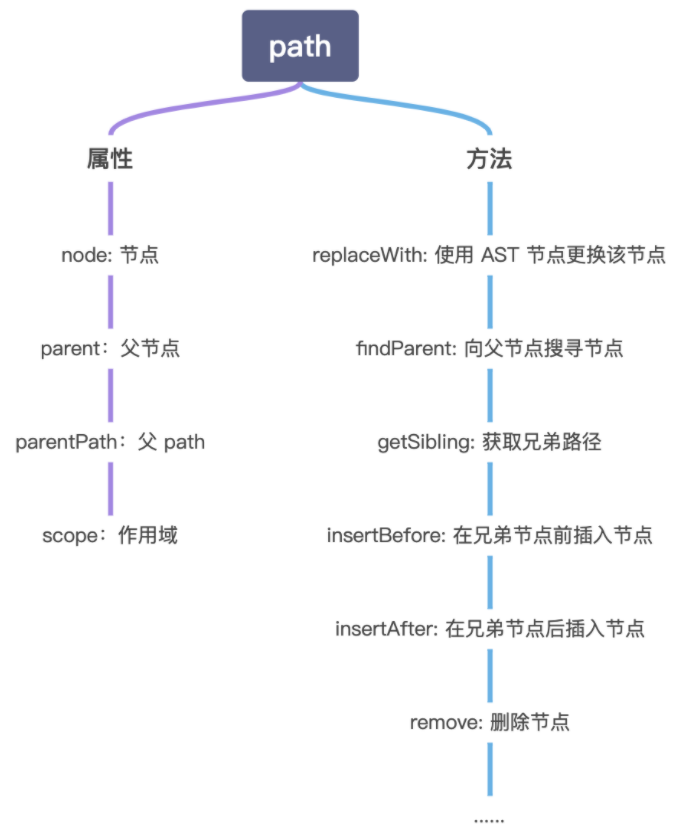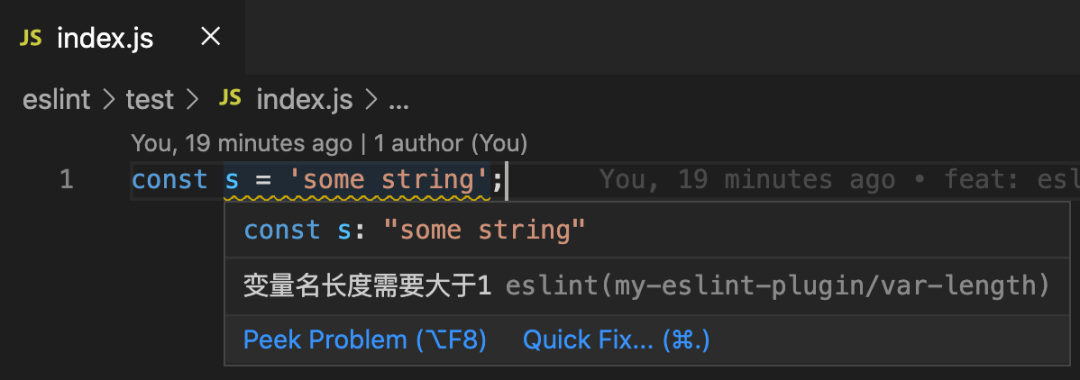用JS解释JS!详解AST及其应用
一 AST 是什么?
1 AST:Abstract Syntax Tree - 抽象语法树
当我们查看目前主流的项目中的 devDependencies,会发现各种各样的模块工具。归纳一下有:JavaScript转译、css预处理器、elint、pretiier 等等。这些模块我们不会在生产环境用到,但它们在我们的开发过程中充当着重要的角色,而所有的上述工具,都建立在 AST 的基础上。
2 AST 工作流程
- parse:把代码解析为AST。
- transform:对AST中的各个节点做相关操作,如新增、删除、替换、追加。业务开发 95%的代码都在这里。
- generator:把AST转换为代码。
3 AST 树预览
AST 辅助开发工具:https://astexplorer.net/
二 从一个简单需求上手
代码压缩的伪需求:将 square 函数参数与引用进行简化,变量由 num 转换为 n:
解法1:使用 replace 暴力转换
const sourceText = `function square(num) {
return num * num;
}`;sourceText.replace(/num/g, 'n');
以上操作相当的暴力,很容易引起bug,不能投入使用。如若存在字符串 "num",也将被转换:
// 转换前
function square(num) {
return num * num;
}
console.log('param 2 result num is ' + square(2));
// 转换后
function square(n) {
return n * n;
}
console.log('param 2 result n is ' + square(2));解法2:使用 babel 进行 AST 操作
module.exports = () => {
return {
visitor: {
// 定义 visitor, 遍历 Identifier
Identifier(path) {
if (path.node.name === 'num') {
path.node.name = 'n'; // 转换变量名
}
}
}
}
};通过定义 Identifier visitor,对 Identifier(变量) 进行遍历,如果 Identifier 名称为 "num",进行转换。以上代码解决了 num 为字符串时也进行转换的问题,但还存在潜在问题,如代码为如下情况时,将引发错误:
// 转换前
function square(num) {
return num * num;
}
console.log('global num is ' + window.num);
// 转换后
function square(n) {
return n * n;
}
console.log('global num is ' + window.n); // 出错了由于 window.num 也会被上述的 visitor 迭代器匹配到而进行转换,转换后出代码为 window.n,进而引发错误。分析需求“将 square 函数参数与引用进行简化,变量由 num 转换为 n”,提炼出的3个关键词为 “square 函数、参数、引用”,对此进一步优化代码。 解法2升级:找到引用关系
module.exports = () => {
return {
visitor: {
Identifier(path,) {
// 三个前置判断
if (path.node.name !== 'num') { // 变量需要为 num
return;
}
if (path.parent.type !== 'FunctionDeclaration') { // 父级需要为函数
return;
}
if (path.parent.id.name !== 'square') { // 函数名需要为 square
return;
}
const referencePaths = path.scope.bindings['num'].referencePaths; // 找到对应的引用
referencePaths.forEach(path => path.node.name = 'n'); // 修改引用值
path.node.name = 'n'; // 修改自身的值
},
}
}
};上述的代码,可描述流程为:
转换结果:
// 转换前
function square(num) {
return num * num;
}
console.log('global num is ' + window.num);
// 转换后
function square(n) {
return n * n;
}
console.log('global num is ' + window.num);在面向业务的AST操作中,要抽象出“人”的判断,做出合理的转换。
三 Babel in AST
1 API 总览
// 三剑客
const parser = require('@babel/parser').parse;
const traverse = require('@babel/traverse').default;
const generate = require('@babel/generator').default;
// 配套包
const types = require('@babel/types');
// 模板包
const template = require('@babel/template').default;2 @babel/parser 通过 babel/parser 将源代码转为 AST,简单形象。
const ast = parser(rawSource, {
sourceType: 'module',
plugins: [
"jsx",
],
});3 @babel/traverse AST 开发的核心,95% 以上的代码量都是通过 @babel/traverse 在写 visitor。
const ast = parse(`function square(num) {
return num * num;
}`);
traverse(ast, { // 进行 ast 转换
Identifier(path) { // 遍历变量的visitor
// ...
},
// 其他的visitor遍历器
}
)visitor 的第一个参数是 path,path 不直接等于 node(节点),path 的属性和重要方法组成如下:
4 @babel/generator 通过 @babel/generator 将操作过的 AST 生成对应源代码,简单形象。
const output = generate(ast, { /* options */ });
5 @babel/types @babel/types 用于创建 ast 节点,判断 ast 节点,在实际的开发中会经常用到。
// is开头的用于判断节点
types.isObjectProperty(node);
types.isObjectMethod(node);
// 创建 null 节点
const nullNode = types.nullLiteral();
// 创建 square 变量节点
const squareNode = types.identifier('square');6 @babel/template @bable/types 可以创建 ast 节点,但过于繁琐,通过 @babel/template 则可以快速创建整段的 ast 节点。下面对比了获得 import React from 'react' ast 节点的两种方式:
// @babel/types
// 创建节点需要查找对应的 API,传参需要匹配方法
const types = require('@babel/types');
const ast = types.importDeclaration(
[ types.importDefaultSpecifier(types.identifier('React')) ],
types.stringLiteral('react')
);
// path.replaceWith(ast) // 节点替换// 使用 @babel/template
// 创建节点输入源代码即可,清晰易懂
const template = require('@babel/template').default;
const ast = template.ast(`import React from 'react'`);
// path.replaceWith(ast) // 节点替换7 定义通用的 babel plugin 定义通用的 babel plugin,将有利于被 Webpack 集成,示例如下:
// 定义插件
const { declare } = require('@babel/helper-plugin-utils');
module.exports = declare((api, options) => {
return {
name: 'your-plugin', // 定义插件名
visitor: { // 编写业务 visitor
Identifier(path,) {
// ...
},
}
}
});// 配置 babel.config.js
module.exports = {
presets: [
require('@babel/preset-env'), // 可配合通用的 present
],
plugins: [
require('your-plugin'),
// require('./your-plugin') 也可以为相对目录
]
};在 babel plugin 开发中,可以说就是在写 ast transform callback,不需要直接接触“@babel/parser、@babel/traverse、@babel/generator”等模块,这在 babel 内部调用了。 在需要用到 @babel/types 能力时,建议直接使用 @babel/core,从源码[1]可以看出,@babel/core 直接透出了上述 babel 模块。
const core = require('@babel/core');
const types = core.types; // const types = require('@babel/types');四 ESLint in AST 在掌握了 AST 核心原理后,自定义 ESlint 规则也变的容易了,直接上代码:
// eslint-plugin-my-eslint-plugin
module.exports.rules = {
"var-length": context => ({ // 定义 var-length 规则,对变量长度进行检测
VariableDeclarator: (node) => {
if (node.id.name.length <= 1){
context.report(node, '变量名长度需要大于1');
}
}
})
};// .eslintrc.js
module.exports = {
root: true,
parserOptions: { ecmaVersion: 6 },
plugins: [
"my-eslint-plugin"
],
rules: {
"my-eslint-plugin/var-length": "warn"
}
};体验效果
IDE 正确提示:
执行 eslint 命令的 warning:
查阅更多 ESLint API 可查看官方文档[2]。
五 获得你所需要的 JSX 解释权 第一次接触到 JSX 语法大多是在学习 React 的时候,React 将 JSX 的能力发扬光大[3]。但 JSX 不等于 React,也不是由 React 创造的。
// 使用 react 编写的源码
const name = 'John';
const element = <div>Hello, {name}</div>;// 通过 @babel/preset-react 转换后的代码
const name = 'John';
const element = React.createElement("div", null, "Hello, ", name);JSX 作为标签语法既不是字符串也不是 HTML,是一个 JavaScript 的语法扩展,可以很好地描述 UI 应该呈现出它应有交互的本质形式。JSX 会使人联想到模版语言,它也具有 JavaScript 的全部功能。下面我们自己写一个 babel plugin,来获得所需要对 JSX 的解释权。
1 JSX Babel Plugin 我们知道,HTML是描述 Web 页面的语言,axml 或 vxml 是描述小程序页面的语言,不同的容器两者并不兼容。但相同点是,他们都基于 JavaScript 技术栈,那么是否可以通过定义一套 JSX 规范来生成出一样的页面表现?
2 目标
export default (
<view>
hello <text style={{ fontWeight: 'bold' }}>world</text>
</view>
);<!-- 输出 Web HTML -->
<div>
hello <span style="font-weight: bold;">world</span>
</div><!--输出小程序 axml -->
<view>
hello <text style="font-weight: bold;">world</text>
</view>目前的疑惑在于:AST 仅可用作 JavaScript 的转换,那 HTML 和 axml 等文本标记语言改怎么转换呢?不妨转换一种思路:将上述的 JSX 代码转化为 JS 的代码,在 Web 端和小程序端提供组件消费即可。这是 AST 开发的一个设计思想,AST 工具仅做代码的编译,具体的消费由下层操作,@babel/preset-react 与 react 就是这个模式。
// jsx 源码
module.exports = function () {
return (
<view
visible
onTap={e => console.log('clicked')}
>ABC<button>login</button></view>
);
};
// 目标:转后为更通用的 JavaScript 代码
module.exports = function () {
return {
"type": "view",
"visible": true,
"children": [
"ABC",
{
"type": "button",
"children": [
"login1"
]
}
]
};
};明确了目标后,我们要做的事为:
- 将 jsx 标签转为 Object,标签名为 type 属性,如
转化为 { type: 'view' } - 标签上的属性平移到 Object 的属性上,如 <view onTap={e => {}} /> 转换为 { type: 'view', onTap: e => {} }
- 将 jsx 内的子元素,移植到 children 属性上,children 属性为数组,如 { type: 'view', style, children: [...] }
- 面对子元素,重复前面3步的工作。下面是实现的示例代码:
const { declare } = require('@babel/helper-plugin-utils');
const jsx = require('@babel/plugin-syntax-jsx').default;
const core = require('@babel/core');
const t = core.types;
/*
遍历 JSX 标签,约定 node 为 JSXElement,如
node = <view onTap={e => console.log('clicked')} visible>ABC<button>login</button></view>
*/
const handleJSXElement = (node) => {
const tag = node.openingElement;
const type = tag.name.name; // 获得表情名为 View
const propertyes = []; // 储存对象的属性
propertyes.push( // 获得属性 type = 'ABC'
t.objectProperty(
t.identifier('type'),
t.stringLiteral(type)
)
);
const attributes = tag.attributes || []; // 标签上的属性
attributes.forEach(jsxAttr => { // 遍历标签上的属性
switch (jsxAttr.type) {
case 'JSXAttribute': { // 处理 JSX 属性
const key = t.identifier(jsxAttr.name.name); // 得到属性 onTap、visible
const convertAttributeValue = (node) => {
if (t.isJSXExpressionContainer(node)) { // 属性的值为表达式(如函数)
return node.expression; // 返回表达式
}
// 空值转化为 true, 如将 <view visible /> 转化为 { type: 'view', visible: true }
if (node === null) {
return t.booleanLiteral(true);
}
return node;
}
const value = convertAttributeValue(jsxAttr.value);
propertyes.push( // 获得 { type: 'view', onTap: e => console.log('clicked'), visible: true }
t.objectProperty(key, value)
);
break;
}
}
});
const children = node.children.map((e) => {
switch(e.type) {
case 'JSXElement': {
return handleJSXElement(e); // 如果子元素有 JSX,便利 handleJSXElement 自身
}
case 'JSXText': {
return t.stringLiteral(e.value); // 将字符串转化为字符
}
}
return e;
});
propertyes.push( // 将 JSX 内的子元素转化为对象的 children 属性
t.objectProperty(t.identifier('children'), t.arrayExpression(children))
);
const objectNode = t.objectExpression(propertyes); // 转化为 Object Node
/* 最终转化为
{
"type": "view",
"visible": true,
"children": [
"ABC",
{
"type": "button",
"children": [
"login"
]
}
]
}
*/
return objectNode;
}
module.exports = declare((api, options) => {
return {
inherits: jsx, // 继承 Babel 提供的 jsx 解析基础
visitor: {
JSXElement(path) { // 遍历 JSX 标签,如:<view />
// 将 JSX 标签转化为 Object
path.replaceWith(handleJSXElement(path.node));
},
}
}
});六 总结
我们介绍了什么是 AST、AST 的工作模式,也体验了利用 AST 所达成的惊艳能力。现在来想想 AST 更多的业务场景是什么?当用户:
- 需要基于你的基础设施进行二次编程开发的时候
- 有可视化编程操作的时候
- 有代码规范定制的时候
AST 将是你强有力的武器。
参考资料
[1]https://github.com/babel/babel/blob/main/packages/babel-core/src/index.js#L10-L14
[2]https://cn.eslint.org/docs/developer-guide/working-with-rules
[3]https://reactjs.bootcss.com/docs/introducing-jsx.html

